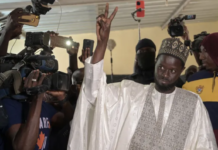There is a music-tech controversy that rivals Bob Dylan’s choice to plug in his guitar at the Newport Folk Festival in 1965. A year earlier, on April 10, 1964, the pianist Glenn Gould made a radical exit from live concerts.
Gould played seven pieces to a packed house at the Wilshire Ebell Theatre in Los Angeles, including four fugues. He gave no indication that the program was his swan song. Then he strolled—he never stormed—away from his Steinway CD 318 and out the door of the concert hall, into the mild California air. A year later, he boarded a train for the desolate Northwest Territories of his native Canada. He never played another concert. When Arthur Rubinstein bet him in 1971 that he’d be back, Gould took the bet; when he died 11 years later, at 50, he won. He came to regard live music as a “blood sport.” He especially held the sociability of concerts in contempt. “Music is something that ought to be listened to in private,” he said.
From that evening on, the pianist’s life became a testament to the raptures of electronic media. In the studio he found something subtler, kinder, and more intimate than what he considered the relationship of dominance and submission between performer and audience. To Gould, sound engineering and music production conveyed, as nothing else, “the spine-tingling awareness of some other human voice or persona.”
Rejecting as priggish the cliché that technology is “depersonalizing,” Gould was smitten. “I was immediately attracted to the whole electronic experience … I fell in love with microphones; they became friends, as opposed to the hostile, clinical inspiration-sappers that many people think they are.”
This summer, as people in many countries are attending concerts and touching each other again, the case for solitude and computers over community and real life seems especially unpersuasive. It would dishonor the pandemic dead not to take life by the horns and go for broke on packed-yard barbecues and front-row tickets to Lady Gaga. But Gould proved at least that an existence heavily mediated by technology is not non-existence. Screen nausea and social media compulsions are no joke, but the current self-loathing about the long year of screen time is misplaced. It was not lost time. Rather, the boring and sometimes hallucinatory quarantine opened new portals for imagination that the culture hasn’t yet begun to assimilate.
Because he idealized northerliness and mused often on solitude, Gould after 1964 is figured as a recluse. But he was hidden away only if you don’t count telephones, photography, recorded sound, recorded video, and speedy distribution networks. For his two electronic decades, Gould managed to be nowhere and everywhere. Though often sequestered, he suffused tens of millions of television sets, movie theaters, car radios, and eventually outer space, when, in 1977, his stunning interpretation of Bach’s Well-Tempered Clavier was launched out of Earth’s atmosphere on the phonographic time capsule aboard the Voyager spacecraft. Gould may be best experienced by curious extraterrestrials, ones with decent turntables or at least working ESP.
Gould had a sweet tooth for some pop music, including Petula Clark; he called Barbra Streisand’s voice “an instrument of infinite diversity and timbral resource.” And though he himself had perfect pitch, he was captivated by unusual speaking voices, off-key or otherwise. He invented a form of documentary film known as contrapuntal, in tribute (maybe) to Bach, in which speaking voices are made to overlap with weird effects. The most evocative example is Gould’s film about the bleak Canadian tundra, The Idea of North, which sits easily among the most avant-garde fare on YouTube.
Though he hummed compulsively while he played, avoided shaking hands for fear of disease, developed an addiction to prescription pills, and dressed for a winter storm whatever the weather, Gould managed to stay in the flicker of electric eccentricity, never quite slipping into the monotony of madness. This delicate psychic balance is palpable in the erudite stem-winders he delivered straight to the camera. It comes through in his experimental acoustic collages and the innumerable radio broadcasts he recorded. Gould also spoke for hours on end to friends and unwitting acquaintances on landlines and pay phones, sometimes putting his companions to sleep as he reeled off theories of everything, a one-man soundscape whose changeable cadences of speech were uncannily like his piano playing. “No supreme pianist has ever given of his heart and mind so overwhelmingly while showing himself so sparingly,” said Gould’s close friend, the violinist Yehudi Menuhin.
Gould became what might be known now as a pandemic musician. Tim Page, the music critic and a close Gould confidant, was asked last year what his friend might have made of quarantine living. “Glenn would have loved the internet,” Page replied. “He was a germophobe and didn’t like much physical contact. But he would have enjoyed things like Skype and Facebook [so he could] still enjoy his friendships while keeping his distance.” Indeed, Gould was at his best at a distance—far from the baroque chamber and the modern stage, holed up where he could send a signal to just one other person, lonely, like him, afraid of touch, across the very same untenanted Canadian expanses that inspired the media philosopher Marshall McLuhan, a frequent interlocutor of Gould.
Between 2016 and 2019, the English musician Leyland Kirby, under the pseudonym the Caretaker, layered and edited samples from old, worn 78s to create an album in stages called Everywhere at the End of Time. The theme of the album is decay and deterioration; each record represents a phase of dementia until, in the last one, the reeling musical signals are all but drowned out by noise, the static of the mind’s final exhalation.
During the pandemic, an extraordinary fate befell Everywhere at the End of Time. It galvanized adolescents. And not just any adolescents—the adolescents of TikTok. Shut up at home, they seemed to find in the recording an opportunity to glut private sorrows and test their intellects on difficult music. In the Caretaker challenge, they dared each other to listen to the whole piece, which runs at six and a half hours, and record their responses in videos. “Literally the definition of pain,” wrote 16-year-old Owen Amble in a caption on the music last fall. “Never cried listening to something.” There are now hundreds of such videos, some with tens of thousands of views.
The vertical TikTok rectangles show young faces, alone, framed as if in a narrow closet. Often the listeners are crying as they listen and listen and listen. “The justification of art is the internal combustion it ignites in the hearts of men and not its shallow, externalized, public manifestations,” Glenn Gould once wrote.
Over the course of the pandemic, housebound students created Spotify and YouTube playlists that offer music not for exercise or seduction but for scholarship. Some of these compilations promote relaxation with lo-fi beats. But others don’t sedate. They keep the isolated mind alive and awake. Work by the Caretaker sometimes makes an appearance on these lists. But it’s baroque music that still best serves the thrill-seeking intellect, and the most stimulating study playlists feature Bach’s Goldberg Variations, performed by Glenn Gould. The tracks are 30 contrapuntal variations beginning and ending with an aria.
This article appears in the July/August issue. Subscribe now.
- 📩 The latest on tech, science, and more: Get our newsletters!
- The full story of the stunning RSA hack can finally be told
- Your clothes spew microfibers before they’re even clothes
- How to turn your phone into a webcam
- The Avengers Campus at Disneyland kinda weirds me out
- What it takes to turn a video game into tabletop one
- 👁️ Explore AI like never before with our new database
- 🎮 WIRED Games: Get the latest tips, reviews, and more
- 🎧 Things not sounding right? Check out our favorite wireless headphones, soundbars, and Bluetooth speakers









